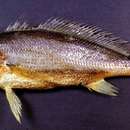Benefits
provided by FAO species catalogs
Caught with bottom trawls, longlines and handlines. The total catch reported for this species to FAO for 1999 was 323 564 t. The countries with the largest catches were China (308 907 t) and Tanzania, United Rep. of (13 490 t). Marketed fresh; also dried-salted. Used in Chinese medicine.
Brief Summary
provided by FAO species catalogs
Benthopelagic. Inhabits coastal waters and estuaries
Size
provided by FAO species catalogs
Attains about 42 cm.
Distribution
provided by FAO species catalogs
Northwest Pacific Ocean; Chefoo, Port Arthur, Manchuria, Sanghai, Shantung Prov., China; coast of Korea and Shimonoseki, Yamaguchi, Honsu, Japan.
Diagnostic Description
provided by FAO species catalogs
Body elongate, compressed. Mouth large, maxillary extending to below posterior margin of eye. Lower jaw little protruding beyond uppern jaw; teeth in a single row on lower jaw; posterior margin of preoperculum with dermal serration. Lateral line with 53 to 59 scales. Dorsal fin with 10 spines and 31-37 soft rays. Anal fin with 2 spines and 9-10 soft rays; second anal espine shorter than eye. Colour body orange-yellow.
Trophic Strategy
provided by Fishbase
Found in the sublittoral zone above 120 m in sandy mud bottoms (Ref. 11230). Feeds on crustaceans, euphausiids and decapods (Ref. 53668). Feeding activity was highest in autumn and lowest in spring and winter (Ref. 53668). Infested by the isopod Nerocila sundaica (Ref. 124798).
- Recorder
- Grace Tolentino Pablico
Morphology
provided by Fishbase
Dorsal spines (total): 10 - 11; Dorsal soft rays (total): 31 - 36; Analspines: 2; Analsoft rays: 9 - 10; Vertebrae: 28 - 30
- Recorder
- Estelita Emily Capuli
Migration
provided by Fishbase
Oceanodromous. Migrating within oceans typically between spawning and different feeding areas, as tunas do. Migrations should be cyclical and predictable and cover more than 100 km.
Diagnostic Description
provided by Fishbase
Body gold when fresh. Soft-rayed portions of dorsal and anal fins mostly covered with scales. Posterior part of pectoral fin not black. Anal soft rays usually 9 (Ref. 41299).
- Recorder
- Estelita Emily Capuli
Biology
provided by Fishbase
Found in the sublittoral zone above 120 m in sandy mud bottoms (Ref. 11230). Used in Chinese medicine (Ref. 12166).
Importance
provided by Fishbase
fisheries: highly commercial; aquarium: commercial; price category: very high; price reliability: reliable: based on ex-vessel price for this species
分布
provided by The Fish Database of Taiwan
分布於西北太平洋區,包括中國渤海、東海及黃海南部。台灣西部及澎湖沿海偶可見。
利用
provided by The Fish Database of Taiwan
以底拖網及底刺網為主要漁法,肉質佳,油炸、清蒸、糖醋皆宜。本種為中國大陸北方沿海最重要的經濟漁獲之一,主要漁場在山東半島東南外海,年產量約5-10萬公噸,近年來由於過漁而產量有日益減少之趨勢,台灣的近海域漁獲量不大。
描述
provided by The Fish Database of Taiwan
體延長,側扁,體側腹部有多列發光顆粒。頭鈍尖形,口裂大,端位,傾斜,吻不突出,上頜長等於下頜,上頜骨後緣達眼眶後緣;上頜最外列齒擴大為犬齒,內列齒細小呈絨毛狀,前端中央無齒,下頜內列齒較大,在下頜前端中央突起上外列齒聚成一小撮齒;吻緣孔5個,內、外側緣孔沿吻緣葉側裂,吻緣葉完整不被分割;吻上孔3個呈弧形排列。頦孔4個,呈四方排列在頤縫合周圍。鼻孔2個,長圓形後鼻孔較圓形前鼻孔大。眼眶下緣伸達前上頜骨頂端水平線。前鰓蓋後緣具鋸齒緣,鰓蓋具2扁棘;具擬鰓;鰓耙細長。頭部及體側前部被圓鱗,體側後部被櫛鱗,背鰭軟條部和臀鰭2/3以上皆有小圓鱗,尾鰭佈滿小圓鱗。耳石為黃花魚型,即呈盾形。背鰭基起點、胸鰭基上緣點及腹鰭基起點到吻端距離大約相等,皆位於鰓蓋末端;尾鰭楔型。腹腔膜褐色,胃為卜字形,腸為2次迴繞型,幽門垂13個,鰾為黃花魚型,前部不突出,附枝27-28對,不延伸至頭部,具有腹分枝及背分枝,背分枝呈翼狀開展,腹分枝則無。體側上半部為黃褐色,下半部為金黃色;下頜前端有褐色斑。背鰭淺褐色;尾鰭前半部金黃色,後部淺褐色;臀鰭金黃色,鰭前緣及後緣為深褐色;腹鰭金黃色;胸鰭淺黃褐色;腹部發光顆粒為橙黃色。口腔白色,口緣粉紅色。鰓腔黑色。
棲地
provided by The Fish Database of Taiwan
主要棲息於沿岸及近海砂泥底質水域,大多棲息於中底層水域,水深約在20-100公尺之間,會進入河口區。厭強光,喜混濁水流,黎明、黃昏或大潮時多上浮,白晝或小潮則下浮至底層。主耍以小魚及蝦蟹等甲殼類為食。鰾能發聲,在生殖期會發出「咯咯」的聲音;在魚群密集時的聲音則如水沸聲或松濤聲;生殖季節在初夏,會群聚洄游至河口附近或島嶼、內灣的近岸淺水域,秋冬則游入較深海域。
Larimichthys polyactis
provided by wikipedia EN
Larimichthys polyactis, called the redlip croaker, small yellow croaker, little yellow croaker or yellow corvina,[2] is a species of croaker native to the western Pacific, generally in temperate waters such as the East China Sea and the Yellow Sea.
Evolution
Phylogenomic studies indicate this species emerged from the same common ancestor of L. crocea around 25.4 million years ago.[3][4]
Diet
They are benthopelagic feeders that usually eat shrimp, zooplankton, or sometimes small fishes.
Habitat
They remain in shallow waters above 120 m, but avoid brackish conditions. They are typically found where the sea floor is sand or mud.
Morphology
Males can reach 42 cm while the common length is about 30 cm. Their body shape is almost rectangular. They have red lips, grey gold body, gold belly and light yellow fins. The inside of its mouth is white and the gill slit is black. In its head are two hard, pale, white bones that keep balance when they swim, which is also used as a material for medicine. They can make noise by moving their air bladder in order not to scatter.
Behavior
They have a habit of leaping above the sea. In winter, they move to warm water. The breeding season is from March to June. Usually they spawn 30,000 ~ 70,000 eggs.
Relation to humans
Once an abundant commercial fish off the coasts of China, Korea and Japan, its population collapsed in the 1970s due to overfishing.[5] Global catch later rebounded, with 388,018 t landed in 2008.[6] Salted and dried, they are a food product known as gulbi (굴비) in Korean. Yeonggwang gulbi is a prized delicacy, selling for over $100 a bunch.
References
-
^ Froese, Rainer; Pauly, Daniel (eds.) (2023). "Larimichthys polyactis" in FishBase. February 2023 version.
-
^ Chai, J. Y.; Chu, Y. M.; Sohn, W. M.; Lee, S. H. (June 1986). "Larval anisakids collected from the yellow corvina in Korea". Kisaengchunghak Chapchi. 24 (1): 1–11. doi:10.3347/kjp.1986.24.1.1. PMID 12886102.
-
^ Xie, Qing-Ping; Zhan, Wei; Shi, Jian-zhi; Liu, Feng; Niu, Bao-Long; He, Xue; Liu, Meng; Liang, Qiqi; Xie, Yue; Xu, Peng; Wang, Xu (2021-08-02). "Whole-genome assembly and annotation of little yellow croaker (Larimichthys polyactis) provide insights into the evolution of hermaphroditism and gonochorism". Authorea Preprints. doi:10.22541/au.162790498.82247747/v1. S2CID 238843975.
-
^ Xie, Qing‐Ping; Zhan, Wei; Shi, Jian‐Zhi; Liu, Feng; Niu, Bao‐Long; He, Xue; Liu, Meng; Wang, Jing; Liang, Qi‐Qi; Xie, Yue; Xu, Peng; Wang, Xu; Lou, Bao (2022). "Whole‐genome assembly and annotation for the little yellow croaker ( Larimichthys polyactis ) provide insights into the evolution of hermaphroditism and gonochorism". Molecular Ecology Resources. doi:10.1111/1755-0998.13731. PMID 36330680.
-
^ Orleans, Leo A., ed. (1980). Science in Contemporary China. Stanford University Press. p. 239. ISBN 978-0-8047-1078-7.
-
^ "Larimichthys polyactis". Fisheries Global Information System. Food and Agriculture Organization of the United Nations. Retrieved 23 November 2010.

- license
- cc-by-sa-3.0
- copyright
- Wikipedia authors and editors
Larimichthys polyactis: Brief Summary
provided by wikipedia EN
Larimichthys polyactis, called the redlip croaker, small yellow croaker, little yellow croaker or yellow corvina, is a species of croaker native to the western Pacific, generally in temperate waters such as the East China Sea and the Yellow Sea.
- license
- cc-by-sa-3.0
- copyright
- Wikipedia authors and editors

